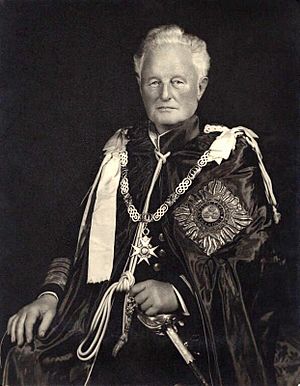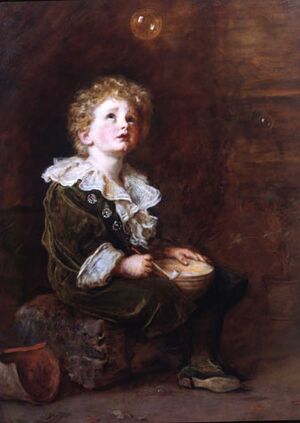William James (Royal Navy officer, born 1881) facts for kids
Quick facts for kids
Sir William Milbourne James
|
|
|---|---|

Sir William Milbourne James wearing the mantle of the Order of the Bath
|
|
| Nickname(s) | "Sir Bubbles" |
| Born | 22 December 1881 Hartley Wintney, Hampshire, England |
| Died | 17 August 1973 (aged 91) Surrey |
| Allegiance | United Kingdom |
| Service/ |
Royal Navy |
| Years of service | 1901–1944 |
| Rank | Admiral |
| Commands held | Chief of Naval Information (1943–44) Portsmouth Naval Base (1939–42) Battlecruiser Squadron (1932–34) HMS Royal Sovereign (1926–27) Royal Naval College, Greenwich (1925–26) HMS Curlew (1919–21) |
| Battles/wars | First World War Second World War |
| Awards | Knight Grand Cross of the Order of the Bath Légion d'honneur (France) |
| Other work | Member of Parliament for Portsmouth North (1943–45) Deputy Lieutenant Surrey (1953–65) President, Union Jack Club (1955–64) |
Admiral Sir William Milbourne James (born December 22, 1881 – died August 17, 1973) was an important British naval officer, a politician, and an author. He served in the Royal Navy from the early 1900s through the Second World War. During the First World War, he played a key role in the early days of the Naval Intelligence Division.
Contents
Early Life and the "Bubbles" Painting
William James was the son of Major W. C. James and Effie, who was the daughter of the famous painter John Everett Millais. William went to school at Trinity College, Glenalmond and later at HMS Britannia, a training ship for the Navy.
The Famous "Bubbles" Painting
When William was a child, his grandfather, the artist Millais, painted him several times. The most famous painting is called Bubbles. In this painting, five-year-old William is shown looking closely at a soap bubble he just blew.
This painting became very well-known when it was used in an advertisement for Pears soap. Because of this famous picture, William was often called "Bubbles" throughout his life.
William James chose to join the Royal Navy and rose through the ranks to hold many important positions.
He started his naval career on the training ship HMS Britannia. In 1901, he became a sub-lieutenant. He was then posted to the destroyer HMS Skate in 1902. Later that year, he was promoted to lieutenant and served on the battleship HMS Venerable in the Mediterranean Sea. By 1913, he had become a commander.
World War I Service
During the First World War, James was an executive officer on the battlecruiser HMS Queen Mary. He left the ship just before it was lost in the Battle of Jutland. From 1916 to 1917, he was a flag commander for Vice Admiral Sir Doveton Sturdee on HMS Benbow.
Later in the war, he worked with William Reginald Hall, who was the Director of Naval Intelligence. James eventually became a deputy director. Hall and James worked together in a secret area called "Room 40". Here, they decoded important enemy messages. These messages helped them understand plans for the Battle of Jutland and even the famous Zimmermann Telegram. At one point, James was in charge of Room 40 himself. He later wrote about these events in a book about Hall.
Between the World Wars
In the years between the two World Wars, James continued his naval service. He was captain of HMS Curlew in China from 1921 to 1922. From 1923, he worked at the Royal Naval College, Greenwich, becoming its Director in 1925.
In 1926, he became flag captain of HMS Royal Sovereign. He then served as Naval Assistant to the First Sea Lord in 1927. He was also Chief of Staff for the Atlantic Fleet in 1929 and the Mediterranean Fleet in 1930.
In 1932, he took command of the Battlecruiser Squadron, with his flag on HMS Hood. He was promoted to vice admiral in 1933. From 1935 to 1938, he was the Deputy Chief of the Naval Staff. He was also honored as a Knight Commander of the Order of the Bath in 1936. By 1938, James had become a full admiral.
World War II and Political Role
During the Second World War, Admiral James was the Commander-in-Chief of Portsmouth Naval Base starting in 1939. In 1940, he led Operation Aerial, which was the evacuation of British troops from France. This was a similar operation to the famous Dunkirk evacuation. In 1942, he became the Chief of Naval Information, managing how the Navy shared news with the public.
In 1943, James was elected as a Member of Parliament for Portsmouth North. He represented the Conservative Party until 1945. He retired from the Navy in 1944.
After retiring from public life, Sir William James supported groups related to sailing and the sea. For example, a sailing club named one of their boats Bubbles in his honor. Most of his time in retirement was spent writing books about British naval history.
Published Works
Besides writing a book about Admiral Hall, he published many other books and articles. These works covered his experiences during the wars and other naval topics. Some of his publications include:
- New battleship organisations and notes for Executive Officers (1916)
- Songs of the sailor men (1916)
- The British Navy in adversity: a study of the American War of Independence (1926)
- Blue water and green fields (1939)
- Admiral Sir William Fisher (1943)
- The Portsmouth letters (1946)
- The British Navies in the Second World War (1946)
- The durable monument: Horatio Nelson (1948)
- The influence of sea power on the history of the British people (1948)
- Old oak : the life of Sir John Jervis, Earl of Vincent (1950)
- The sky was always blue (1951)
- The eyes of the navy: a biographical study of Admiral Sir Reginald Hall (1955)
- A great seaman: the life of Admiral of the Fleet Sir Henry Oliver (1956)
His most well-known book that wasn't about the Navy was The Order of Release (1947). This book shared family letters that told the story of his grandparents, Effie Gray and John Everett Millais. Effie Gray had been married to John Ruskin before she fell in love with Millais. William James was the first to publish the full details of this story. His book helped to clear his grandmother's name and show her side of the story. James's book has even inspired plays.


